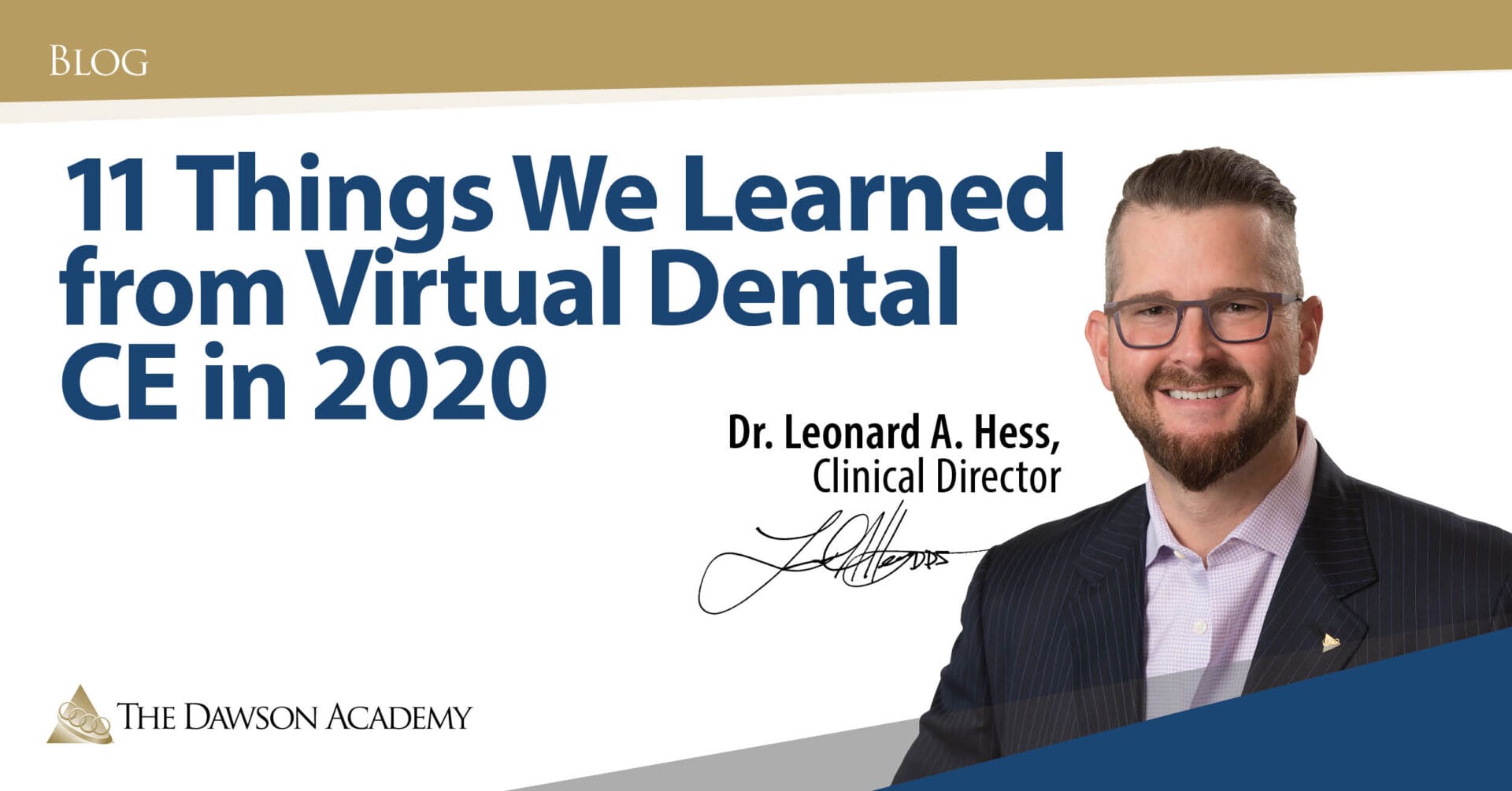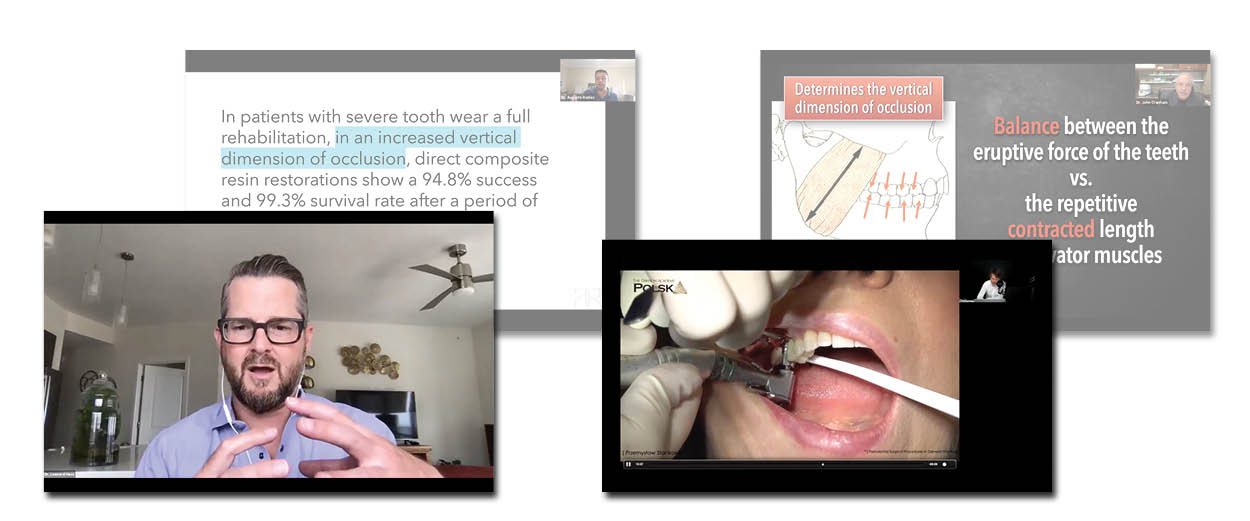
11 Things We Learned from Virtual Dental CE in 2020

What a challenge our profession and industry faced last year amid the COVID-19 pandemic. They say that necessity is the mother of invention, and in our case at The Dawson Academy, this necessity was a quick pivot to be sure we could meet your 2020 continuing education needs.
We conformed to our situations and adopted 11 live stream courses throughout the year catered to make your career as a Complete Dentist more of a reality from anywhere in the world. Our 2020 live streams courses were a tremendous success. We had many interesting topics which provided hundreds of dentists with thousands of hours of CE credit. We learned contemporary updates on such a wide range of topics and tried to deliver a wide range of variety for dentists, technicians, and specialists.
Here is what we learned in 2020 from our team of expert instructors:
Splint therapy doesn’t have to be complicated or confusing
In May, I hosted ‘Demystifying Splints: Going Beyond the Night Guard’ to help dentists identify exactly which splint to apply with a patient exhibiting signs and symptoms of TMD. The goal was to relieve frustration and increase patient confidence. From participants:
“After taking the course, I was able to immediately treat and evaluate my patients for splint therapy.”
“This was a great course that reviews TMD and the reason why splints are needed, what type of splint to use, and how-to treat TMD prior to treating a patient comprehensively.”
After this course, participants were able to accurately identify the different types of splints and what they treat, how-to diagnose patients properly to prescribe the correct appliance, and avoid complications by developing successful treatment plans.
You can shape your general practice into a cosmetic practice
In June, Drs. John Cranham and Zachary Sisler taught ‘Shaping the Cosmetic Practice: From Ordinary to Exceptional’ to communicate their vision of how-to transform a run-of-the-mill neighborhood practice into a cosmetic practice for esthetic and elective care. From participants:
“This class will give you some foundational concepts to begin offering predictable cosmetic dental treatments to your patients.”
“The checklists and methods that the Academy teaches make something complex become so much more predictable and successful.”
After attending this course, students were empowered to develop a vision and steps for shaping a cosmetically-focused practice, identify data points and records needed for anterior esthetic cases, recognize photography and its use for case acceptance, follow a 6-step systematic treatment planning process, and foster a marketing brand and social media image that resonates with their customers.
Posterior wear is the enemy of a stable occlusion
Also in June, Dr. John Cranham led ‘Functional Esthetics: Designing Stable Cosmetic Restorations’ to help us understand The Dawson Academy’s timeless occlusal principles and how they can be utilized to manage, force, and create stable, minimal-stress occlusions. From participants:
“This course had practical, up-to-date information that was presented in an effective and engaging manner. It’s a great review of things that we may forget to check.”
“Go in and take this course knowing that you’ll understand occlusion and the methods of clinical predictability.”
The key takeaways from this course include how-to recognize the esthetically driven patient who has underlying functional problems, how-to design a stable, minimal-stress occlusion, determine and identify which treatment plans and options are right for your patient for optimum esthetics and function, and explain how to align the most current ceramic system based on patient needs.
General practice orthodontics begins with Invisalign®
In July, Drs. Andrew Reingold and John Cranham co-taught ‘Invisalign® Essentials for Complete Dentistry’ to help attendees raise their understanding of GP orthodontics to tackle more cases, obtain better results, and achieve increases of case acceptance and predictability. From participants:
“This is a good course for those of us who want to do more Invisalign® but might not have the confidence to initiate cases. The information helps to distinguish between cases that are appropriate for general dentists and those that may be beyond our help and require referral. As always, they reiterated the importance of occlusion and how convenient it is to reset some teeth to improve occlusion before restoring, which is a really valuable skill for general dentists.”
Following the live stream course, participants were equipped to clarify case selection, discuss the records process, determine the biomechanics of aligner orthodontics, incorporate ClinCheck Pro tools and workflows, utilize an Invisalign Progress checklist, and discuss troubleshooting and collaboration tactics with orthodontists.
Digital workflows improve your predictability, profitability, and efficiency
In August, Dr. John Cranham and Mr. Lee Culp, CDT hosted ‘The Transition to Digital: Modernizing Dawson Workflows’ to give dentists the ability to digitize their workflows from the Complete Examination to the restorative process. From participants:
“Learning how to implement Complete Dentistry digitally was awesome. I can’t wait to implement the material in my practice.”
“The course was packed with tips, tricks, and facts relative to digital dentistry. This is must-see if you’re thinking about moving in the digital direction.”
Upon completion of this course, students were able to explain how-to scan and capture a bite in centric relation, paraphrase how-to mount on a virtual articulator in minutes, visualize and conduct a virtual equilibration, summarize virtual diagnostic waxing, and implement new ways to print and mill provisional restorations.
Removable prosthodontics education falls short in dental school
Also in August, Dr. Kimberley Daxon led ‘Amazing Dentures: How Sweet the Sound!’ to review the basic removable prosthodontics principles and techniques to give students a higher level of confidence when making their next set of Complete dentures. From participants:
“This course was a great recap of the basics while also elevating the experience and expectations for dentures.”
“It was a great course to improve your ability to help treat patients with dentures while achieving consistent and predictable results.”
Students walked away from Dr. Daxon’s live stream course ready to examine anatomy to support a Complete denture, articulate various impression techniques, summarize how-to appropriately contour wax rims, determine vertical dimension, explain the recording of centric relation with wax rims, and restate how-to achieve a Complete denture occlusion.
Both biological and functional techniques improve missing teeth restorations
In September, Drs. Glenn DuPont and Pio Modi co-led ‘Replacing Missing Teeth: From Partials to Implants’ to show how important it is to be able to design a well-fitting removable partial denture that actually strengthens the teeth as the teeth support the partial. From participants:
“The first section was dedicated to replacing missing teeth with partial dentures, whereas the second section was dedicated to replacing missing teeth with implants.”
After taking this course, participants were able to explain the biological, functional, and restorative parameters needed for successful implant placement, practice grafting and site development techniques, determine whether to guide or not, implement a plan to develop an implant surgical practice, and identify the three key components of removable partial denture design (RPD).
Successful adhesion treatment is the key to minimally invasive dentistry
In October, Dr. Dorota Stankowska taught ‘Master Adhesion – From Direct Composite Through Inlay and Onlay to Complex Cases’ with a goal to show us the step-by-step procedures for different treatments with correct techniques – transforming your direct composites to become beautiful and functional. From participants:
“It was a great course that not only teaches foundational skills, but skills that can take your clinical results to a new level.”
“If you want to be better at adhesive dentistry and offer minimally invasive dentistry, take this course.”
Afterwards, students were able to put this knowledge into practice Monday morning following step-by-step processes and can now determine when to use adhesive techniques in complex cases.
All-on-four treatment is challenging, yet rewarding, complex dentistry
In November, Dr. John Cranham led ‘All-on-Four: The Good, the Bad and the Ugly’ with the objective of decreasing your chances of failed implant cases. From participants:
“It was a great course to gain knowledge about full arch therapy.”
“This was a great place to get the techniques, steps, and jewels to make your implant procedures easier.”
Following the live steam course, participants were able to list the critical esthetic and functional factors for ideal case planning, design a stable occlusion for an all-on-four implant prosthesis, conduct virtual implant placements in various ways, determine when to immediately load a case and which cases should be placed in a denture first, apply three different step-by-step approaches to successfully load all-on-four/five/six cases, and breakdown the different ways their cases fail and how-to avoid them.
Composite materials and techniques constantly evolve
Also in November, Dr. Augusto Robles taught ‘Caries, Adhesives, Composites: Making Sense for Success’ to give dentists a fast-paced review of current caries, adhesion, and composite concepts and materials. From participants:
“It felt good to go back to basics and new studies and findings and new materials and techniques. It will help be a better restorative dentist.”
“This course is a must-take at any stage of your career. It helps to keep up-to-date with bonding protocols and will help you become a better practitioner.”
Participants of Dr. Robles’s course walked away being able to acquire clear insight of the caries process, explain why, when, where, and where not to conduct caries excavation, implement currently available adhesion systems and composite materials, tips, and techniques for great posterior direct restorations.
Periodontal surgery is possible in a general practice
In December, Dr. Przemysław Stankowski led ‘Periodontal Surgical Procedures in the General Practice’ with a goal of improving your general practice by learning and implementing some simple surgical techniques. The live stream course featured videos from live surgery and interactive exercises students could do at home. From participants:
“This is an important course to learn about the periodontal aspects of implant placement, esthetic crown lengthening, flaps and grafting. Even if you won’t be applying this to your own practice, being knowledgeable in the principles will help you make informed decisions when planning treatment for your patients.”
After attending this course, general practitioners were able to describe the steps to manage an extraction socket, explain the process for an immediate implant placement, summarize the techniques and steps to cover recession, recite the crown lengthening process, and implement a step-by-step procedure for soft tissue grafting around implants and teeth.
Onward and upward in 2021
I would like to thank our speakers Dr. Glenn Dupont, Dr. Augusto Robles, Dr. Leonard Hess, Dr. Kimberley Daxon, Dr. John Cranham, Dr. Pio Modi, Dr. Zachary Sisler, Dr. Dorota Stankowski, Dr. Drew Reingold, and Dr. Perry Stankowski for their time and expertise – what a great lineup of internationally recognized speakers.
If you missed these great lectures, you can still purchase the recordings on our website by clicking on the links in the sections above. You’ll get 30-day access to the live stream recording, course materials and handouts, and qualifying CE credit.
Looking ahead, you can check out our new lineup of live stream courses for 2021 here. I’ll be starting things off with Establishing Examination and Records for Complete Care on January 22, 2021. Stay tuned for more – and thank you for striving to become an even better dentist with all of us at the Academy.
Sincerely,

Leonard A. Hess, DDS
Clinical Director
The Dawson Academy









Leave a Reply
Want to join the discussion?Feel free to contribute!